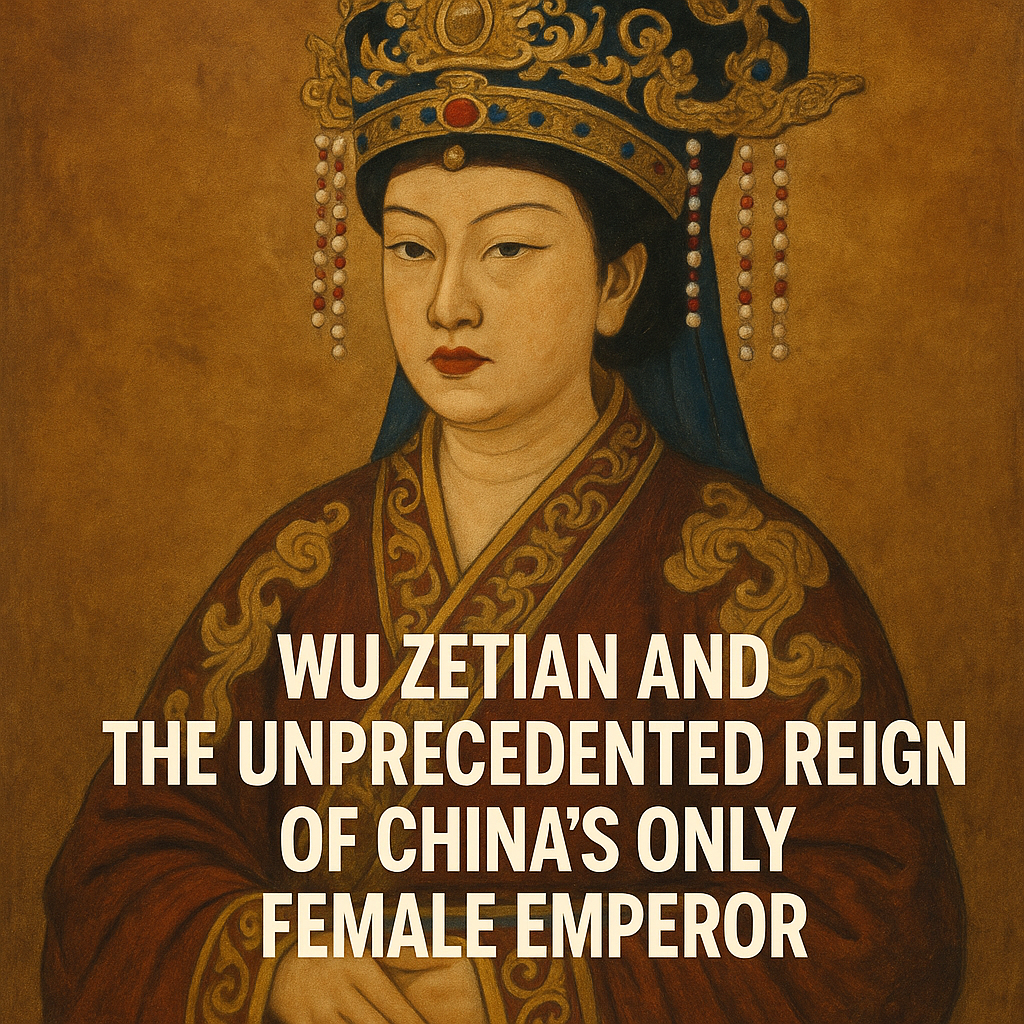Wu Zetian rose from concubine to emperor, rewriting history as China’s only female sovereign with unmatched intelligence, ambition, and political mastery.
- Early Life And Rise Through The Tang Court
- The Road To Empress And The Elimination Of Rivals
- Wu Zetian’s Reign As Emperor Of China
- Cultural Contributions And Religious Patronage
- Challenges To Her Rule And The Fall Of The Zhou Dynasty
- Legacy And Historical Reassessment
- Follow My Journey And Get Inspired To Transform Your Life For The Better
Early Life And Rise Through The Tang Court
Born in 624 CE in Wenshui, Shanxi province, Wu Zhao—later known as Wu Zetian—was raised in a wealthy, well-educated family. Unlike many girls of her time, she received an education in literature, music, and history. Her father, a successful timber official and a patron of the arts, believed in female education, which set Wu apart early in life.
At the age of 14, Wu entered the imperial court of Emperor Taizong as a concubine, though not one of his favorites. Her role at this stage was relatively minor, but she studied court politics with keen observation. After Taizong’s death in 649, she was expected to live the rest of her life in a Buddhist convent. However, her story was far from over.
Wu caught the attention of the new emperor—Taizong’s son, Gaozong—before Taizong’s death. When Gaozong ascended the throne, Wu re-entered the palace, not as a retired concubine, but as a woman determined to change her fate. Her wit, intelligence, and calculated charm helped her rise swiftly within the ranks, eventually becoming Gaozong’s most influential consort.
The Road To Empress And The Elimination Of Rivals
Wu’s ambition knew no limits, and the route to power in a rigid patriarchal society required both strategic alliances and ruthless decisions. Her rise to Empress Consort in 655 was not smooth or without bloodshed. Her most infamous maneuver involved the alleged murder of her infant daughter—a tragic act she used to frame Empress Wang and another consort, Consort Xiao. Both rivals were deposed, paving the way for Wu’s elevation.
As Empress, Wu wielded considerable influence over Emperor Gaozong, who was often in poor health. Many historians speculate that she functioned as a co-ruler long before Gaozong’s official declaration of her as regent. Her position allowed her to build a network of loyal officials, suppress political opposition, and begin molding the empire in her vision.
Wu’s elimination of rivals extended to powerful courtiers and members of the aristocracy. She used a combination of secret police, purges, and laws to root out corruption—sometimes genuinely, sometimes as a veil for eliminating enemies. While her methods were often harsh, they also brought a new level of administrative efficiency and accountability to the imperial government.
Wu Zetian’s Reign As Emperor Of China
In 690, Wu Zetian made history by declaring herself Emperor of China, founding the short-lived Zhou Dynasty and officially displacing the Tang. This move was nothing short of revolutionary. No woman had ever held the title of “Huangdi,” the supreme sovereign. Her assumption of power defied not only Confucian orthodoxy but centuries of cultural tradition that saw women as inherently unsuited for political leadership.
Wu’s reign was marked by major political and economic reforms. She promoted officials based on merit rather than lineage, giving rise to a more inclusive bureaucracy. The imperial examination system—used to select civil servants—was expanded under her rule, helping to break the monopoly of power held by aristocratic families.
In terms of foreign policy, Wu was assertive and strategic. She maintained peaceful relations with neighboring states and managed to protect and even expand China’s borders. Internally, she invested in agriculture, public works, and religious institutions, helping to stabilize the empire and increase prosperity.
Religion also played a key role in her legitimacy. Wu championed Buddhism, which was more favorable toward female rulers compared to Confucianism. She commissioned grand statues and temples, including the famous Longmen Grottoes, portraying herself as a divine ruler chosen by the heavens.
Cultural Contributions And Religious Patronage
Wu Zetian’s reign wasn’t just about power—it was also a cultural renaissance. She was a patron of the arts and literature, supporting scholars, poets, and calligraphers. Her court attracted thinkers from across the empire, and she encouraged literary competitions and philosophical debates.
One of her notable contributions to the Chinese language was the creation of new Chinese characters, many of which were meant to reflect the uniqueness and authority of her reign. Though most of these characters didn’t survive beyond her dynasty, they show the extent to which she sought to reshape even the linguistic fabric of the nation.
Her devotion to Buddhism reshaped religious life in China. She promoted Mahayana Buddhism, which emphasized the universality of enlightenment and allowed greater roles for women within the faith. Under her sponsorship, Buddhist texts were translated and disseminated across the empire. She also used Buddhist scriptures to justify her rule, claiming divine prophecy had foretold the rise of a female emperor.
Temples flourished under her regime, and massive sculptures were carved in her image. The immense seated Buddha at Longmen is often thought to bear her likeness—a visual reminder of how she intertwined the sacred and the political.
Challenges To Her Rule And The Fall Of The Zhou Dynasty
Despite her achievements, Wu Zetian’s rule was not without turmoil. Court intrigue, rival factions, and public resentment mounted over time. Her use of a secret police force created a climate of fear, and her favoritism toward certain younger male courtiers toward the end of her reign sparked scandal.
Opposition grew not only among the nobility but also within her own family. Many Tang loyalists viewed her rule as illegitimate, a deviation from the rightful dynasty. The question of succession loomed large, as she struggled to find a suitable heir amidst familial rivalries and political complications.
In 705, after ruling China for 15 years as emperor and nearly half a century as a political force, Wu Zetian was forced to abdicate. A palace coup orchestrated by high-ranking officials and family members brought her reign to an end. The Tang Dynasty was restored under Emperor Zhongzong, one of Wu’s sons.
She was not executed, however, nor completely erased from history. She was given a dignified burial in the Qianling Mausoleum, alongside Emperor Gaozong. Remarkably, her tomb bears no epitaph—only a blank stele, perhaps symbolizing that no words could fully capture the complexity of her legacy.
Legacy And Historical Reassessment
For centuries, Wu Zetian’s legacy was distorted by Confucian historians who portrayed her as a tyrant, a seductress, and a murderer. These accounts emphasized her cruelty and ambition while downplaying her intellect and contributions. Traditional Chinese historiography, steeped in patriarchal norms, struggled to accept a woman in a role of ultimate authority.
But in recent decades, historical reassessment has brought a more nuanced view. Scholars have begun to recognize the remarkable administrative reforms, the expansion of meritocracy, and the cultural advancements that marked her rule. She not only maintained but strengthened the empire during a time of potential decline.
Modern perspectives, especially those influenced by feminism and global studies of women in power, see Wu Zetian as a complex and visionary leader. She defied the norms of her era, reshaped an empire, and left a legacy that still fascinates historians, writers, and readers around the world.
Her story remains relevant today—not just as a tale of political ambition, but as a testament to resilience, intellect, and the breaking of barriers. Wu Zetian didn’t just rule China. She redefined what leadership could look like, and in doing so, carved her name permanently into the story of world history.
I am working on building a passive income stream using the internet. If you would like to do the same take a look at this business by clicking here.
This business can be operated using the internet and the start up cost is low. I don’t have to leave my current employment to work on building this global business.
If you like what you see, work with me to build a passive income stream using this global business.
I do not provide personal investment or financial advice and I am not a qualified licensed investment advisor. I am documenting my online investment and financial journey and what’s working for me. Click Here to read disclaimer.
If you found value in this post and want to support my work, click here to buy me a coffee.
Subscribe to my list for valuable updates, tools, videos and articles that I will share as I come across them.
Let me know your thoughts on this post via the comments section. You can also add your insights and suggestions.
If you enjoyed reading this post or it added some value, please share it with others.

Follow My Journey And Get Inspired To Transform Your Life For The Better
“I may earn commissions as an affiliate from sponsored links within this post”





